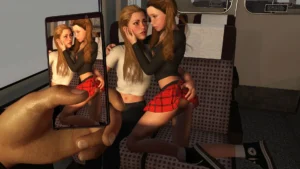
A Girl on a Train
Play A Girl on a Train
A Girl on a Train review
Exploring the Unique Features and Experience of This Interactive Title
If you’ve heard about ‘A Girl on a Train’ and are curious what this interactive experience is all about, you’re not alone. This title has sparked interest for its unique setting and narrative-driven approach. Unlike traditional games, it immerses players in a story that unfolds aboard a train, blending choice, consequence, and character interaction. In this article, we’ll take a deep dive into what makes ‘A Girl on a Train’ different, how it plays, and what you can expect from its content. Whether you’re a seasoned player or just exploring, this guide will help you decide if it’s the right fit for you.
What Is ‘A Girl on a Train’?
So you’ve heard people talking about “A Girl on a Train” game and you’re wondering what all the fuss is about? 🤔 You’re in the right place. In simple terms, it’s an interactive train story that puts you in the shoes of a protagonist on a rail journey, where every conversation and decision you make weaves a unique narrative. It’s less about winning or losing and more about experiencing a story that is profoundly your own.
I remember the first time I booted it up, not knowing what to expect. Within minutes, I was completely absorbed. The rhythmic sound of the train on the tracks, the passing landscapes, and the mysterious strangers in my carriage created a sense of tension and intimacy I hadn’t felt in other games. It was this unique blend that hooked me. 🚆
### The Premise and Setting
At its heart, the “A Girl on a Train” game is a character-driven drama unfolding within the confined, moving world of a locomotive. You aren’t just watching a story set on a train; you are living inside it. The train itself is a character—a metallic serpent carving through cities and countryside, its compartments becoming stages for confession, conflict, and connection.
The brilliance of this train setting game is its inherent drama. 🎭 You’re trapped in a metal tube with a cast of characters, all with their own secrets and destinations. The setting isn’t static; it evolves. A sunny morning journey feels hopeful and open, while a late-night ride through a storm feels claustrophobic and tense. The world outside the window changes, reflecting and influencing the mood of the story within.
My Pro Tip: Pay close attention to the scenery. The developers often use the changing landscape as subtle emotional cues for the narrative. A shift from sunny fields to a dark tunnel often mirrors a turning point in the plot.
This confined space forces interactions and makes every encounter feel significant. There’s no escaping to a different zone; you must engage with the people and the problems right here, right now. This is the core of its immersive power.
### Gameplay Mechanics and Choices
If you’re coming from traditional games, the mechanics here will feel refreshingly different. The primary tool at your disposal is choice. This is the definition of narrative-driven gameplay, where the core loop is built on observation, conversation, and decision-making.
You’ll navigate through beautifully illustrated scenes and engage in dialogues with other passengers. And here’s the crucial part: player choices matter. This isn’t an illusion. The game remembers your actions, big and small.
- Dialogue Choices: What you say directly shapes your relationships. A kind word can unlock a character’s hidden backstory, while a suspicious accusation might shut them down for the rest of the journey.
- Action Decisions: Sometimes, you’re presented with physical choices. Do you look through someone’s belongings? Do you intervene in an argument? These moments often have the most dramatic consequences on the story outcomes.
- Exploration: Click around your cabin and other accessible areas. You might find a discarded newspaper that provides a crucial clue or a personal item that sparks a new conversation topic.
The game is designed for multiple playthroughs. The first time you play, you’ll experience one story. The second time, making different choices, you’ll uncover entirely new plot threads and endings. This is where the phrase player choices matter truly comes to life. You’re not just selecting options; you’re an author collaborating on the script.
To illustrate how “A Girl on a Train” stands out in the genre of narrative games, let’s look at a quick comparison.
| Feature | ‘A Girl on a Train’ | Other Narrative Games |
|---|---|---|
| Setting | Confined, moving train; a constant, dynamic backdrop | Often open-world or multiple static locations |
| Choice Mechanics | Heavy focus on dialogue and relational consequences; choices feel immediate and personal | Can include inventory puzzles or larger-scale world-altering decisions |
| Replay Value | Extremely high due to branching relationships and multiple nuanced endings | Varies; often focuses on a few major ending branches |
### Character Interaction and Storytelling
This is where the magic happens. The “A Girl on a Train” game lives and dies by the quality of its character interaction. Every person you meet on board is intricately designed with their own motivations, fears, and desires. You’re not just collecting quests; you’re building—or breaking—relationships. 👥
The storytelling is not delivered to you; it’s pulled from the characters through your engagement. You learn about the world and the central mysteries by talking to the reclusive writer in cabin B, the anxious businessperson constantly checking their phone, or the friendly conductor with a story for every stop.
The character interaction is so nuanced that sometimes what isn’t said is as important as what is. A character avoiding eye contact or abruptly changing the subject can be a more powerful clue than any direct statement. This is a game that rewards empathy and careful observation.
Let me give you a concrete example of how a single choice can branch the narrative. Imagine a scenario where another passenger, let’s call him Leo, confesses he’s running from a dangerous situation.
The game presents you with a choice:
1. “You can trust me. Tell me everything.” 🤝
2. “That sounds risky. I don’t want to get involved.” 🚫
3. “I think you should tell the conductor.” 🎫
- Choosing option 1 might cause Leo to open up, revealing a key piece of the overarching plot and making him a loyal ally for the rest of the journey.
- Choosing option 2 could make him retreat into silence, locking you out of his subplot permanently and potentially putting him in greater danger later.
- Option 3 might lead to an immediate intervention by authorities, drastically altering the course of the story and how other characters perceive you.
See? This is the narrative-driven gameplay in action. A single dialogue box isn’t just flavor text; it’s a fork in the road. 🛤️
My Pro Tip: For your first playthrough, resist the urge to reload saves after a “bad” choice. The most authentic and powerful stories in this interactive train story often come from dealing with the unintended consequences of your actions. It makes the experience uniquely yours.
The culmination of all this is the profound sense that the story outcomes are a direct reflection of your personality as a player. Are you nosy and investigative? Kind and nurturing? Cautious and distant? The game will hold up a mirror, and the ending you get will feel earned.
So, as you prepare to board this unforgettable interactive train story, remember to talk to everyone, listen closely, and don’t be afraid to follow your curiosity. Your journey in the “A Girl on a Train” game is waiting to be written, one choice at a time. ✨
‘A Girl on a Train’ stands out in the world of interactive narratives by offering a richly detailed setting, meaningful player choices, and a story that changes with every decision. Whether you’re drawn to its unique train environment, the depth of its characters, or the thrill of uncovering hidden content, there’s something here for fans of mature, story-driven experiences. If you’re ready to step aboard and see where your choices take you, now’s the perfect time to give it a try—just remember to explore every car, talk to every character, and enjoy the journey.















